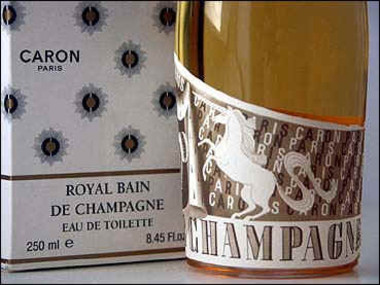The legal campaign for Champagne name
January 3, 2005 - Miami Herald - Business Monday

PARIS - Most holiday revelers have recovered from consuming perhaps a bit too much bubbly on New Year’s Eve, but chances are that quite a few of them wouldn’t be able to say that what they drank was really Champagne from the Champagne region of France.
Could it instead have been ‘‘sparkling wine’’ disguising itself under the Champagne name?
Tracking down Champagne impostors and stamping out the misuse of the name on not only sparkling wine but products as diverse as yogurt and bubble bath is serious business in France where the Champagne region produced more than 293 million bottles of bubbly in 2003.
Nicolas Ozanam, known in France as the ‘‘Champagne detective,’’ is secretary general of the Comité Interprofessionel du Vin de Champagne, the Interprofessional Committee of Champagne Wines, a 19,000-member trade association.
He works with a team of lawyers and researchers to stamp out what Champagne producers see as the unjust appropriation of the prestigious Champagne name and the ensuing negative impact on the product’s integrity.
Protecting the Champagne name can be an arduous process, but ‘‘most times, the dispute can be remedied outside of court,’’ Ozanam says.
Through September, Ozanam and the CIVC have worked through more than 140 cases of name misuse in France and 30 outside of the country.
Looking at the products that have used the name sheds some light on the CIVC’s battle. Often times the name usurpers’ products have nothing to do with Champagne and they are just looking for a way to jack up prices and/or the perception of quality.
Ozanam and his associates have bags full of so-called Champagne knickknacks and products accumulated and thwarted along the way, including non-French sparkling wine labeled Champagne, ‘‘Champagne’’ soap, ‘‘Champagne’’ skin care products, a Swedish ‘‘Champagne’’ yogurt and a Norwegian-style lemon-lime drink called Champagnes Brus.
The CIVC has also stopped a bubble bath made by Caron Paris perfumes and even a sandpaper disc maker that was using ‘‘champagne’’ in its brand name.
The fate of French Chablis exporters is a cautionary tale for Ozanam and the CIVC. Outside the United States, French-produced Chablis is considered a high-quality wine with a strong selling price. But in the United States poor quality non-French versions have literally dragged it down to cardboard boxes on the bottom shelves of U.S. stores.
French vintners are required to uphold legal standards, which non-European countries often do not have to deal with, that guarantee to the consumer that a carefully delineated list of criteria have been followed in their products’ creation.
Topping that list is origin.
One development this year that Ozanam is most happy about allows European customs officers to verify the authenticity of name-controlled products and destroy counterfeit items. Ozanam points to these examples of the system at work: bottles destroyed in Germany after leaving Switzerland and a Holland-bound Argentine ‘‘champagne’’ shipment that was stopped and destroyed in Belgium.
Slowly, Ozanam’s efforts with the CIVC are paying off. A Swedish yogurt, for example, which started off as ‘‘Yoggi Champagne’’ and was touted in advertisements showing people at glamorous parties holding yogurt instead of Champagne flutes, has been vanquished. Swedish courts agreed the name was misleading and ‘‘improperly used another business owner’s activities, products, trademarks or similar characteristics.’‘
The CIVC has taken on companies large and small. In the early 1990s, French courts found that Yves St. Laurent’s ‘‘Champagne’’ perfume created ‘an attractive effect borrowed from the prestigious appellation ‘Champagne’ ‘’—and YSL lost both a trademark and the right to sell the product.
The United States remains a source of frustration for the CIVC, producing two to three times as much ‘‘Champagne’‘’ as it imports. After the 1995 signing of the WTO Agreement on Trade-Related Aspects of Intellectual Property Rights, the United States theoretically barred any new producers from appearing, but this still remains fuzzy for Champagne and other wines such as Chianti and port.
A handful of American companies—Korbel, Gallo and Constellation Brands (Cook’s champagne, Black Velvet Rodeo whiskey and Manischewitz wines) among them—have U.S. authorization in what amounts to grandfathered rights to continue using the Champagne name on their sparkling wines.
‘‘They keep getting bigger,’’ says Ozanam who laments the large number of bottles the American companies produce and the dollars they make thanks to the word ‘‘champagne’’ on their labels.
Not everyone, however, is content to let the Champagne name remain with the French. At the Transatlantic Forum on Geographic Indicators held in Washington, D.C., in October, 2002, some U.S. trade officials questioned whether Champagne (the bubbly) actually got its name from Champagne (the region).
‘‘They even suggested that Champagne’s economic value could be due to the work of California growers. This was worse than Stalinist Russia!’’ half-jokes an exasperated CIVC official.
In 2003, two similar forums took place in Washington and San Francisco.
Without overwhelming help from the U.S. government, reform in the wine industry is coming from the industry itself. New U.S. standards on how the United States imports wine went into effect Jan. 1. ‘‘It’s difficult to know what’s going to happen, but it’s going to make a lot of paperwork,’’ said Ozanam.
Along with the Napa Valley Vintner’s Association fight to keep ‘‘Napa Ridge’’ wines made with grapes from outside of California’s Napa area from reaching the shelves, Ozanam does see a few positive industry trends in the U.S.
‘‘In California, people are starting to decide to put their brand names forward [instead of using ‘champagne’],’’ he says.